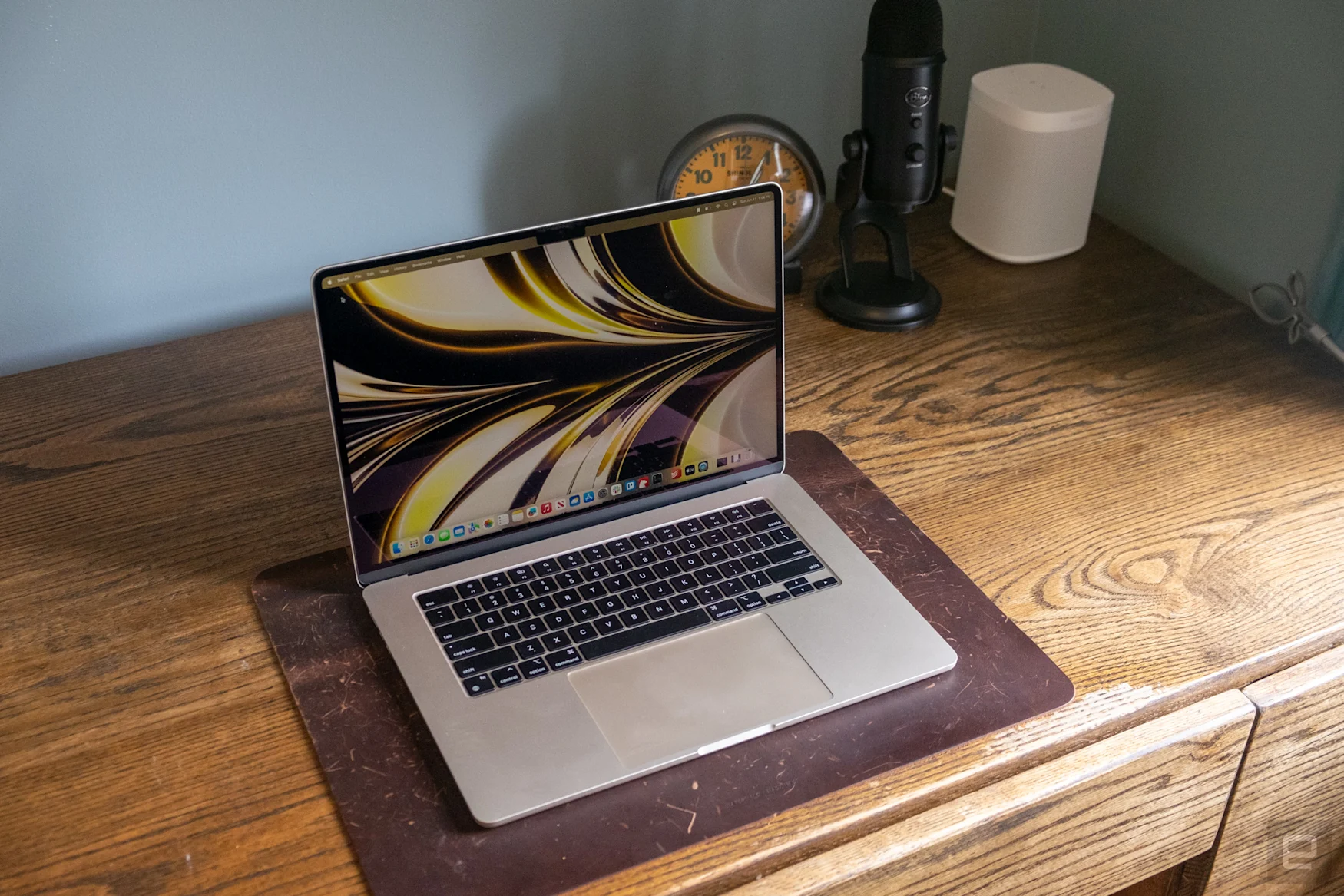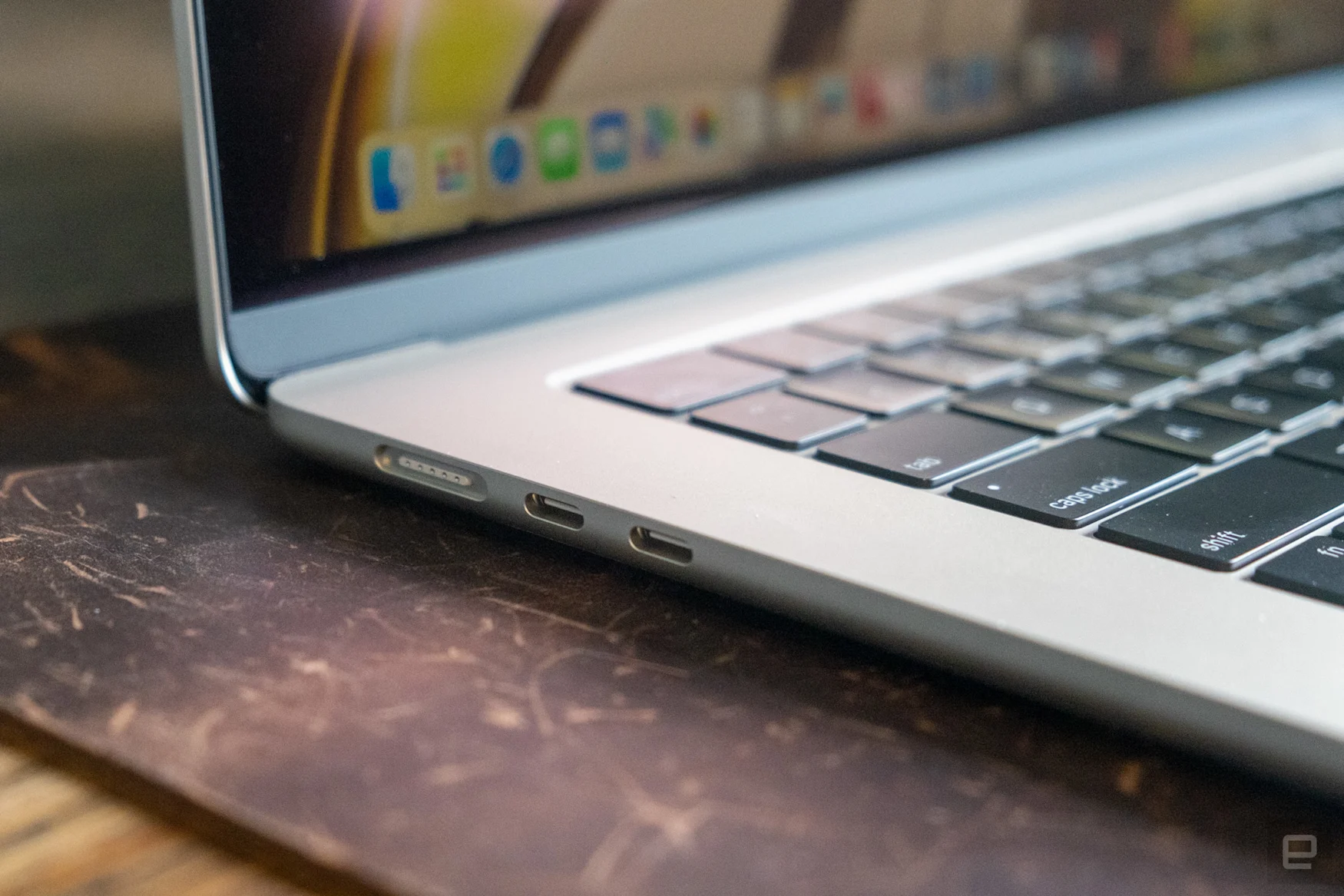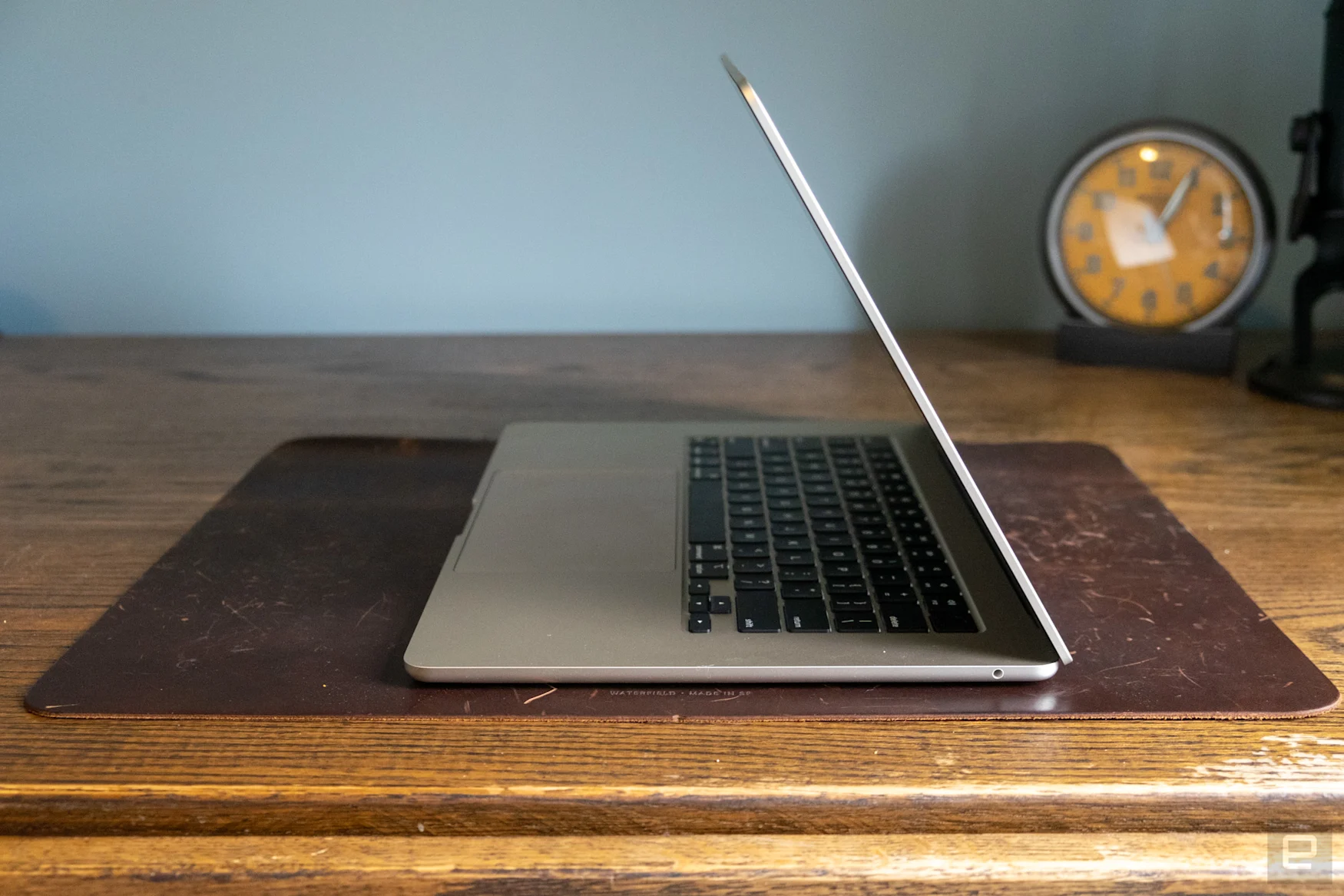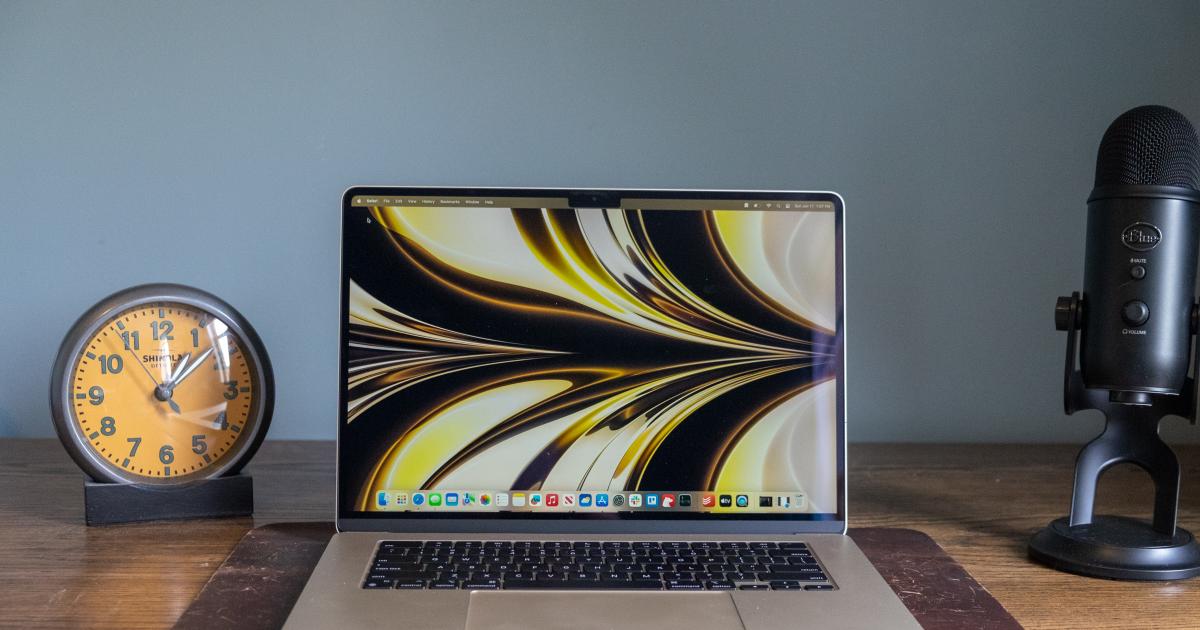When Apple announced the 15-inch MacBook Air last week, it was exactly what you’d expect. Apple simply took the design and internals of the M2-powered Air it announced a year ago and stuck it in a bigger case with a bigger screen. Done and done.
As such, I went into this review thinking it would be a simple assignment. “It’s a MacBook Air, but bigger.” But that undersells the actual experience of using the 15-inch MacBook Air. See, for a long time, a 15-inch Mac was my ideal computer, from the days of the first titanium-clad PowerBook G4 through the 15-inch MacBook Pro Apple sold a decade ago. Those laptops were powerful and had a screen big enough to use all day, but they were also compact enough to take anywhere. In recent years, though, Apple really leaned into the “Pro” designation, with the price skyrocketing well above $2,000, making it cost-prohibitive for most people.
Apple
Apple MacBook Air (15-inch, 2023)
Pros
- Impressive performance from the M2 chip
- A large and lovely display
- Great battery life
- Excellent sound
- Top-tier keyboard and trackpad
Cons
- M2 chip is now a year old
- Display refresh rate is only 60Hz
But the M2-powered, 15-inch Air brings me back to those days. I could easily see using this laptop as my only computer. Like the 13-inch model, it’s powerful, has long battery life and a high-quality (if not cutting-edge) display. It’s also surprisingly thin and light, another hallmark of the Air lineup. And with a starting price of $1,299, it’s significantly more affordable than any laptop that Apple has offered with this size screen.
There are only a few things that the MacBook Air doesn’t have in common with its smaller sibling. Most obvious is the 15.3-inch display with a 2,880 x 1,864 resolution. That works out to 224 pixels per inch, the same as the 13-inch Air. It’s one of Apple’s “Liquid Retina” displays, which has 500 nits of brightness, support for the P3 “wide color” gamut and a modest 60Hz refresh rate.
It’s missing the niceties you’ll find in the mini LED displays on the 14- and 16-inch MacBook Pro, including a much more dramatic contrast ratio, support for HDR, slightly more pixels per inch and a 120Hz max refresh rate. But Apple’s standard displays are still very nice, and the MacBook Air’s screen is bright, sharp and entirely pleasant to look at for extended periods of time. I use a MacBook Pro as my daily driver, and while I noticed the lower refresh rate at first, I mostly forgot about it after a short while.


Photo by Nathan Ingraham / Engadget
The rest of the differences between the two Air models are minor. The base 15-inch model comes with the 10-core GPU variant of the M2 to power the bigger display’s extra pixels; the 13-inch has an 8-core GPU by default. The other internal specs are similar for both base models: 8GB of RAM and 256GB of storage. (The model I’m testing has 16GB of RAM and 512GB of storage, a configuration that costs $1,699.)
The 15-inch Air also has a six-speaker sound system with “force-canceling woofers” for improved bass, compared to a four-speaker setup in the smaller model. Apple has been making surprisingly excellent laptop speakers for a few years now, and these also sound very lively and full when playing back music or movies. They’re not nearly as good as the ones in the 16-inch MacBook Pro, but that laptop is significantly thicker and heavier than the Air; that extra space surely helps with resonance and bass. But the speakers in the Air still sound lively and fun to listen to. Cranking the volume up to the max reveals the lack of bass, but I was happy to listen to music at mid-range volume all day long.
Beyond those things, the 15-inch Air is just a slightly bigger version of the 13-inch model. It has the same relatively meager port selection: just two USB-C ports, MagSafe for power and a headphone jack. The laptop comes in the same four colors (or, more accurately, shades of gray). The keyboard, large trackpad and Touch ID sensor are all excellent, which is true of all Mac laptops at this point. The butterfly keyboard debacle is fortunately a distant memory.


Photo by Nathan Ingraham / Engadget
Unsurprisingly, it sports the same design language that Apple first unveiled with the MacBook Pro refresh a few years ago and then carried over to the Air last year. That means the Air’s formerly iconic wedge shape is gone, replaced with a uniform thickness of less than half an inch, noticeably thinner than the 16-inch MacBook Pro and about identical to the 13-inch Air. Naturally, the 15-inch Air is heavier and bigger in other dimensions, but it still feels extremely thin and also far more portable than either of the MacBook Pro models.
There’s also a notch in the display for the 1080p webcam — again, the same one we’ve seen on other recent MacBooks. It’s much better than the old camera Apple was using until recently, and I don’t mind trading the notch for an improved webcam. The bezels around the display are otherwise nice and thin: not quite as thin as those on the MacBook Pro, but not thick enough for me to give them a second thought.
Gallery: MacBook Air (15-inch, M2) review photos | 10 Photos
Gallery: MacBook Air (15-inch, M2) review photos | 10 Photos
Performance-wise, the 15-inch Air is also essentially identical to the smaller model. Geekbench 5 scores were almost the same as those we got when testing both the 13-inch Air and 13-inch MacBook Pro, both of which also use the M2 chip. The same goes for Cinebench R23 and a few others we tried. It’s worth noting that while single-core performance is similar to the 14-inch MacBook Pro with an M2 Max chip, multi-core and graphics performance is where the M2 can’t quite keep up. That said, for most users, there’s plenty of power here.
|
Model |
Geekbench 5 CPU |
Geekbench 5 Compute |
Cinebench R23 |
|
MacBook Air 2023 (M2, 15-inch) |
1,903/8,928 |
27,870 |
1,595/7,893 |
|
MacBook Air 2022 (M2, 13-inch) |
1,907/8,665 |
27,083 |
1,576/7,372 |
|
MacBook Pro (M2 Max, 14-inch) |
1,970/15,338 |
71,583 |
1,603/14,725 |
|
Dell XPS 15 2022 (Intel i7-12700H, RTX 3050 Ti) |
1,680/11,412 |
60,205 |
1,724/13,100 |
Performance-wise, the 15-inch Air is also essentially identical to the smaller model. Geekbench 5 scores were almost the same as those we got when testing both the 13-inch Air and 13-inch MacBook Pro, both of which also use the M2 chip.


Photo by Nathan Ingraham / Engadget
Beyond the benchmarks, the 15-inch Air is just as capable as the smaller model we reviewed last year — it can handle most computing tasks without breaking a sweat, and despite having no fans, I never really noticed it getting warm. Of course, that changes a bit if you’re running games or doing more intense tasks like video editing. But my workflow, which consists of dozens of tabs open across multiple Safari windows along with apps like Mail, Slack, Music, Trello, Todoist, Bear and Lightroom, didn’t cause any hiccups. To be fair, these aren’t taxing apps, but dipping into Lightroom to edit some large RAW photos didn’t tax the computer either.
My only concern is that this brand-new Air is running a chip that’s already about a year old. It’s so powerful that this shouldn’t be a problem for the Air’s target audience, but it’s still something worth considering. If you’re going to spend more than $1,000 on a laptop that you’ll likely own for years, the ideal situation is to start out with the newest, fastest, most future-proof tech that you can afford. The M2, as capable as it is, has been around for a while already. If you want bleeding-edge Apple silicon you might be better served with a MacBook Pro or waiting for the next Air refresh. But given that Apple just released this computer with the M2 chip inside, it’s fair to say the company is in no hurry to release an M3.
All of the Apple silicon laptops I’ve tried have had outstanding battery life, and the 15-inch Air is no exception. It exceeded the 18 hours that Apple claims for video playback by about an hour before eventually running out of juice. And while the battery didn’t quite last as long during my normal work routine, I still got about 12 hours before I needed a charger. I easily got through the work day and still some power left for some couch browsing and messaging. I think it’s safe to say most people can charge overnight and then not worry about plugging in again until their day is over.
One thing to note on battery, though. Apple offers a compact 35W dual-port charger, which is handy if you want to have your computer charger and another cable right at hand. But after using more powerful chargers for the last few years, this one definitely felt pokey — while I was using the Air, it took about two hours to charge from 45 percent to full while in use. Since Apple gives you the option of swapping in a single-port 70W for no extra charge, I’d recommend that if charging speeds are at all important to you. On the other hand, the battery lasts so long that just charging it more slowly overnight, when speed doesn’t matter, is also a fine option.
As usual, Apple dropped a lot of hyperbole about how the 15-inch Air compares to the “most popular 15-inch Windows laptop running an Intel i7 chip.” The claims are that the Air is much faster, the screen is better, the battery is longer while the laptop itself is thinner and lighter. Apple is being very deliberate about these claims, but the MacBook Air does stack up well compared to some of the most popular 15-inch laptops available.
Dell’s XPS 15 is one of the best overall laptops out there, and the $1,299 base model has double the RAM and storage of the Air. You can also get one with a discrete graphics card, which can make a big difference in more demanding tasks. But it’s also much thicker, a pound heavier and has a lower-resolution display and webcam. Microsoft’s Surface Laptop 5 is probably a closer comparison for the Air – it’s a little bit thicker and heavier, but more svelte than the XPS 15, and has a higher-resolution screen. But it doesn’t have the newest Intel, and the M2 bests the 12th-generation chip that it does offer.


Photo by Nathan Ingraham / Engadget
As you’re surely aware, the 15-inch MacBook Air is little more than a bigger version of the computer that Apple released a year ago. But that’s damming it with faint praise when actually this is one of the best Apple laptops I’ve used in a long time. It does everything the 13-inch MacBook Air does with a noticeably larger screen and only a modest price increase. The only real catch is that I think the RAM and storage in the base model is rather stingy, not an unusual tactic for Apple. The M2 smokes even with only 8GB of RAM, but consider adding more if you want your computer to remain speedy for years to come.
If you travel a lot, or value portability above all else, by all means get the 13-inch model. But if I were in the market for a new laptop right now, I think the 15-inch Air would be at the top of my list. It’s fast, light and extremely pleasant to use. And getting a big screen in a compact package is just icing on the cake.
This story originally appeared on Engadget

